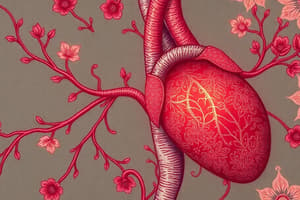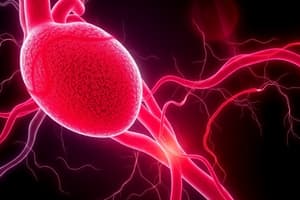Podcast
Questions and Answers
What is the main factor that determines how much blood flows through a tissue or organ?
What is the main factor that determines how much blood flows through a tissue or organ?
Vascular resistance
Vasodilation increases vascular resistance and decreases blood flow.
Vasodilation increases vascular resistance and decreases blood flow.
False (B)
The heart receives the largest percentage of blood flow at rest.
The heart receives the largest percentage of blood flow at rest.
False (B)
What is meant by "cardiac output"?
What is meant by "cardiac output"?
Blood flows from areas of high pressure to areas of low pressure.
Blood flows from areas of high pressure to areas of low pressure.
What is the main law that describes the factors affecting blood flow?
What is the main law that describes the factors affecting blood flow?
According to Poiseuille's Law, how does blood flow change if the radius of a blood vessel is doubled?
According to Poiseuille's Law, how does blood flow change if the radius of a blood vessel is doubled?
Which of the following physiological processes is primarily responsible for increasing blood flow to skeletal muscles during exercise?
Which of the following physiological processes is primarily responsible for increasing blood flow to skeletal muscles during exercise?
Angiotensin II and ADH (at high levels) cause vasoconstriction, which increases resistance and raises blood pressure.
Angiotensin II and ADH (at high levels) cause vasoconstriction, which increases resistance and raises blood pressure.
Which of the following is NOT a paracrine regulator that promotes relaxation of blood vessels?
Which of the following is NOT a paracrine regulator that promotes relaxation of blood vessels?
What is the primary mechanism that maintains fairly constant blood flow to the brain despite variations in blood pressure?
What is the primary mechanism that maintains fairly constant blood flow to the brain despite variations in blood pressure?
Exercise-induced dilation of coronary vessels is primarily due to extrinsic regulation.
Exercise-induced dilation of coronary vessels is primarily due to extrinsic regulation.
What is the name of the oxygen-storage molecule in heart muscle that helps maintain blood supply during systole?
What is the name of the oxygen-storage molecule in heart muscle that helps maintain blood supply during systole?
Cerebral blood flow is significantly affected by sympathetic activity.
Cerebral blood flow is significantly affected by sympathetic activity.
What two major intrinsic mechanisms regulate cerebral blood flow?
What two major intrinsic mechanisms regulate cerebral blood flow?
What role does the skin play in thermoregulation?
What role does the skin play in thermoregulation?
Arteriovenous anastomoses are important for regulating blood flow through the surface capillaries of the skin.
Arteriovenous anastomoses are important for regulating blood flow through the surface capillaries of the skin.
Flashcards
Vascular Resistance
Vascular Resistance
The amount of blood flowing through a tissue or organ, determined by the resistance of the blood vessels.
Vasodilation
Vasodilation
Dilation of blood vessels, decreasing resistance and increasing blood flow.
Vasoconstriction
Vasoconstriction
Constriction of blood vessels, increasing resistance and decreasing blood flow.
Pressure Difference (ΔP)
Pressure Difference (ΔP)
Signup and view all the flashcards
Flow Rate
Flow Rate
Signup and view all the flashcards
Resistance (R)
Resistance (R)
Signup and view all the flashcards
Flow Rate Formula
Flow Rate Formula
Signup and view all the flashcards
Poiseuille's Law
Poiseuille's Law
Signup and view all the flashcards
Sympathoadrenal Activation
Sympathoadrenal Activation
Signup and view all the flashcards
Skeletal Muscle Vasodilation
Skeletal Muscle Vasodilation
Signup and view all the flashcards
Vasodilation (Sympathetic)
Vasodilation (Sympathetic)
Signup and view all the flashcards
Vasoconstriction (Sympathetic)
Vasoconstriction (Sympathetic)
Signup and view all the flashcards
Parasympathetic (Vasodilation)
Parasympathetic (Vasodilation)
Signup and view all the flashcards
Angiotensin II
Angiotensin II
Signup and view all the flashcards
Antidiuretic Hormone (ADH)
Antidiuretic Hormone (ADH)
Signup and view all the flashcards
Endothelium
Endothelium
Signup and view all the flashcards
Nitric Oxide (NO)
Nitric Oxide (NO)
Signup and view all the flashcards
Endothelin 1
Endothelin 1
Signup and view all the flashcards
Autoregulation
Autoregulation
Signup and view all the flashcards
Myogenic Control
Myogenic Control
Signup and view all the flashcards
Metabolic Control
Metabolic Control
Signup and view all the flashcards
Active Hyperemia
Active Hyperemia
Signup and view all the flashcards
Heart (Aerobic)
Heart (Aerobic)
Signup and view all the flashcards
Myoglobin
Myoglobin
Signup and view all the flashcards
Systole
Systole
Signup and view all the flashcards
Diastole
Diastole
Signup and view all the flashcards
Coronary Blood Flow Regulation
Coronary Blood Flow Regulation
Signup and view all the flashcards
Blood Flow Shunting
Blood Flow Shunting
Signup and view all the flashcards
Stroke Volume (SV)
Stroke Volume (SV)
Signup and view all the flashcards
Cardiac Output (CO)
Cardiac Output (CO)
Signup and view all the flashcards
Ejection Fraction
Ejection Fraction
Signup and view all the flashcards
Cerebral Circulation
Cerebral Circulation
Signup and view all the flashcards
Cutaneous Blood Flow
Cutaneous Blood Flow
Signup and view all the flashcards
Study Notes
Factors Affecting Blood Flow
- Blood flow through tissues and organs is influenced by vascular resistance.
- Vasodilation decreases resistance and increases blood flow.
- Vasoconstriction has the opposite effect.
Estimated Distribution of Cardiac Output at Rest
- The gastrointestinal tract and liver receive 24% of cardiac output at rest (1,400 mL/min).
- Kidneys receive 19% (1,100 mL/min).
- The brain receives 13% (750 mL/min).
- The heart itself receives 4% (250 mL/min).
- Skeletal muscles receive 21% (1,200 mL/min).
- Skin receives 9% (500 mL/min).
- Other organs combined comprise 10% (600 mL/min).
Physical Laws Describing Blood Flow
- Blood flow is driven by a pressure difference across the vascular system (ΔP = P1 - P2).
- Flow rate is directly proportional to the pressure difference.
- Flow rate is inversely proportional to resistance (Flow = ΔP/R).
- Resistance is proportional to vessel length (L) and blood viscosity and inversely proportional to the 4th power of the vessel radius.
Poiseuille's Law
- Poiseuille's Law describes factors affecting blood flow.
- Blood flow is directly proportional to the fourth power of the radius (r4)and the pressure difference (ΔP).
- Blood flow is inversely proportional to the length of the vessel (L) and blood viscosity (η).
- Flow = ΔPr^4 / (8η*L)
Extrinsic Regulation of Blood Flow
- Sympathoadrenal activation increases cardiac output (CO) and peripheral/visceral resistance, increasing blood flow to skeletal muscles.
- Skeletal muscle arterioles dilate in response to epinephrine and norepinephrine, which promotes blood flow.
- Blood is diverted from visceral and skin tissues to skeletal muscle.
- Parasympathetic nervous system stimulation generally has vasodilatory effects, primarily on the digestive tract, genitalia, and salivary glands.
Paracrine Regulation of Blood Flow
- Endothelium releases paracrine factors, such as nitric oxide (NO), bradykinin, and prostacyclin that promote vascular relaxation.
- Nitric oxide is crucial in setting the resting tone of blood vessels.
- Vasodilator drugs like nitroglycerin act through NO.
- Endothelin 1 is a vasoconstrictor produced by the endothelium.
Intrinsic Regulation (Autoregulation) of Blood Flow
- Intrinsic mechanisms maintain a relatively constant blood flow despite blood pressure changes.
- Myogenic control: vascular smooth muscle contracts when stretched (high pressure) and relaxes when not stretched (low pressure).
- Metabolic control: blood flow adjusts to match local tissue needs. Low O2, high CO2 or H+ levels stimulate vasodilation to increase blood flow to meet metabolic demands (active hyperemia).
Aerobic Requirements of the Heart
- The heart needs a consistent, adequate blood supply to meet its high aerobic demands.
- Each myocardial cell is close to a capillary.
- Myocardium contains many mitochondria and aerobic enzymes.
Coronary Blood Flow Regulation
- Sympathetic activity affects coronary blood flow; norepinephrine causes vasoconstriction; epinephrine causes vasodilation.
- Exercise-induced dilation is primarily due to intrinsic factors.
Circulatory Changes During Exercise
- Exercise initiates sympathetic activity leading to vasodilation in active skeletal muscles due to epinephrine and norepinephrine release.
- Blood flow is diverted from non-essential tissues (viscera, skin).
- Brain blood flow remains relatively constant.
- With prolonged exercise, intrinsic vasodilation factors in active skeletal muscles are more significant.
- Sympathetic stimulation increases cardiac output (CO) and stroke volume (SV), but also increases vascular resistance due to increased heart rate (HR) and ejection fraction.
Cerebral Circulation
- The brain receives approximately 15% of resting cardiac output (750 mL/min).
- Cerebral blood flow is relatively constant across various conditions to maintain consciousness.
- Cerebral blood flow is primarily regulated intrinsically.
- Cerebral arterioles constrict when blood pressure increases and dilate when it decreases.
- Arteriolar dilation/constriction is responsive to local changes in CO2 levels and neural activity (metabolic regulation).
Cutaneous Blood Flow
- Skin acts as a heat exchanger for thermoregulation.
- Skin blood flow adjusts to maintain a core body temperature of 37°C.
- Changes in blood flow are mediated by arterial dilation/constriction with the participation of arteriovenous anastomoses.
- Sympathetic activity dramatically changes blood flow to skin, directing blood flow to/away from the skin depending on temperature or the "fight or flight" response.
Studying That Suits You
Use AI to generate personalized quizzes and flashcards to suit your learning preferences.



